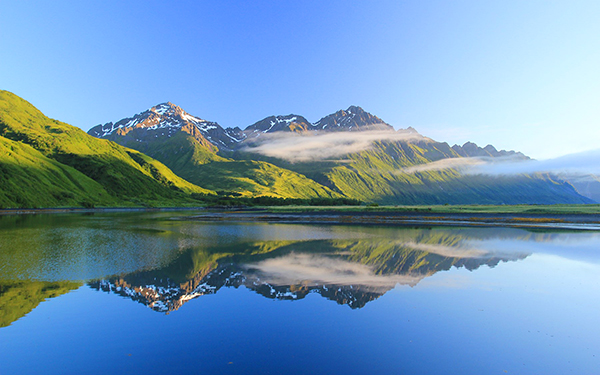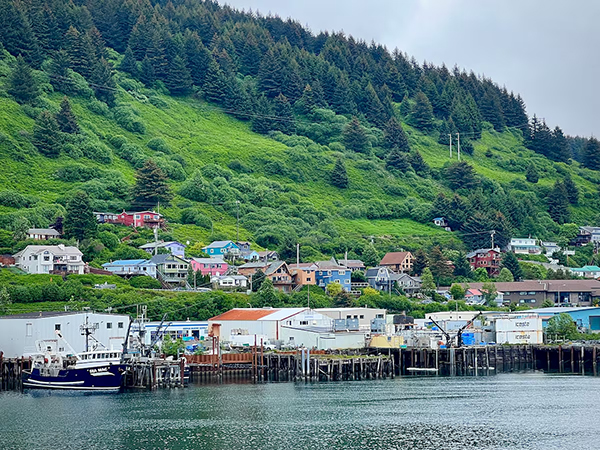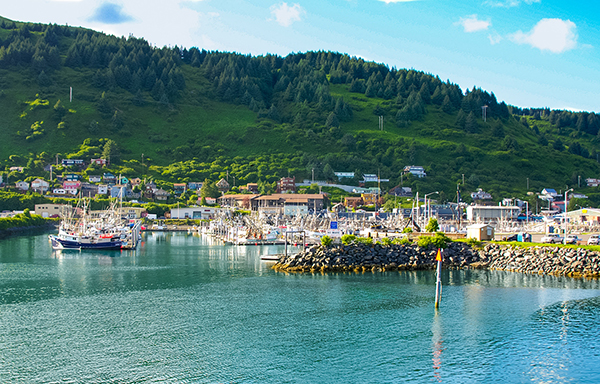

|
|
 |
 |
 |
|
July 26, 2025 Marti Eicholz Traveling from Anchorage to Kodiak Island, Alaska, a part of the Kodiak archipelago, a large group of islands that’s shaped like a kidney bean roughly the size of Connecticut in the northwest corner of the Gulf of Alaska typically involves a journey that combines land and sea transportation, driving or flying from Anchorage to Homer, then taking the ferry to Kodiak Island, a 9.5-hour ride. But we are on The Odyssey, headed for Japan and a stop on Kodiak Island, the Emerald Isle, provides moments to enjoy the stunning, rugged coastal scenery, lush forests, the abundant wildlife like bears, eagles, marine mammals, and an opportunity to fish or kayak. Kodiak, Alaska is the second-largest island (the island of Hawaii is larger) in the United States and is home to the world's largest U.S. Coast Guard base and a large commercial fishing port, focusing on salmon, halibut, and crab. Kodiak is known for its unique brown bears, the Kodiak brown bear, a subspecies of the grizzly bear known for its large size, adult male reaching 1,000 pounds like polar bears, the Alutiiq people who have inhabited the island for over seven thousand years, a presence still felt today, and its role as a historical hub in Russian Alaska. Kodiak has a diverse rich history, including Russian settlement and influence, once the capital of Russian Alaska and its Russian Orthodox Church (an architecture reminder of the past), played a key role in the lucrative fur trade. The Baranov Museum highlights this period. The island also has a strong Alutiiq presence. Explore the Alutiiq Museum, Baranov Museum, or the Kodiak Maritime Museum to learn about the island's history and culture. Ten thousand years ago, glaciers covered the area and chiseled the islands into jagged peaks, wide valleys, deep bays with no land more than fifteen miles from the ocean. The first people of Kodiak arrived more than 8,000 years ago. They traveled in skin boats along the Aleutian Chain, a string of islands that stretches from Russia to the Alaska mainland. In 1792, Russian fur hunters and traders established Kodiak as a commercial port and the first capital of Russian America. The Russian American Magazine, the oldest wooden building on the West Coast of North America, is in the City of Kodiak. In 1808, Russian craftsmen built a warehouse using local spruce logs to store furs. The building still stands, overlooking the harbor in downtown Kodiak. Alaska was purchased from Russia in 1867 for $7.2 million. During the Klondike Gold Rush many fortune seekers came to Alaska. In 1912, Volcano Mount Novarupta erupted, covering the town with several feet of ash. During World War II, Kodiak grew from a small fishing village of four hundred residents to a major staging area in the North Pacific when the U.S. Navy built a large base in Kodiak. The only World War II battle fought on American soil took place here. Explore Fort Abercrombie, a historical park. Built during World War II provides a glimpse into the island’s role in the war. The fort now houses part of the Coast Guard base. Hike the trails, enjoy the beaches, and learn about military history. In 1964, the Great Alaska earthquake triggered a series of tsunamis that wiped out Kodiak’s boat harbor, waterfront, and central business district. The 30-foot waves took fifteen lives, and the earthquake that caused it raised some parts of the islands permanently by thirty feet. Approximately 13,500 people live throughout the Kodiak Island Archipelago. The main population centers are the City of Kodiak and six remote native villages. Ninety percent of Kodiak Island is designated brown bear habitat with 3,500 Kodiak brown bears living on the island. Kodiak is also the natural habitat for a small mammal, the little brown bat. Kodiak has a temperate climate, characterized by cool, wet, and windy summers and winters. The average summer temperature is 12 C and a winter average at -1 C. A large population of Emperor Geese and Steller’s Eiders winter in Kodiak. Kodiak is a major fishing port, particularly known for salmon. All five species of wild Pacific salmon – chinook, sockeye, coho, humpback, and chum – return to spawn in one of the eight hundred salmon streams. Learn about the commercial fishing industry at the Kodiak Maritime Museum. Visit the Kodiak National Wildlife Refuge and learn about conservation efforts. The Refuge protects the island's bear, elk, deer, and wild horse habitat. Observe the Kodiak brown bears and other wildlife, especially during salmon runs. Theodore Roosevelt created the Kodiak National Wildlife Refuge during his presidency. Kodiak Island is a place to hike, fish, go beachcombing, or simply enjoy the natural beauty that surrounds. Kodiak has an impressive 99% renewable energy system, relying on hydroelectric power. Kodiak is rare, like the Hope Diamond. Both have spectacular beauty. Both are nature’s handiwork. After nearly a month, The Odyssey is sailing away from Alaska, “The Last Frontier,” a land that has more than one hundred volcanoes and volcanic fields, a land with more than three thousand rivers and three million lakes, a land that is home to seventeen of North America’s tallest mountains and has 34,000 miles of coastline more than the rest of the U.S. combined. Ladies, if you are looking for a man, Alaska has a higher male-to-female ratio than any other U.S. state. |
|
Copyright © 2025 All rights reserved |